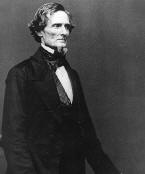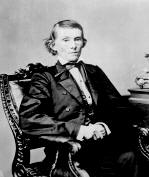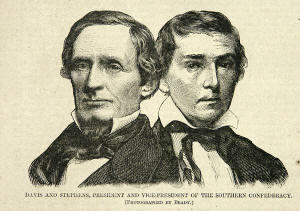|

President Jefferson Davis |
|

Vice-President Stephens |
PRESIDENT DAVIS AND VICE-PRESIDENT STEPHENS. Harper's Weekly, February 23, 1861 The accompanying portraits of Jefferson Davis and Alexander Stephens will introduce to our readers the newly-elected President and Vice-President of the new Southern Confederacy, organized at
Montgomery, Alabama, on 4th February. JEFFERSON DAVIS, the new President, was born in Kentucky about 1806, and is consequently about 54 years old. Having migrated to the Territory of Mississippi, with his father, when a boy, he owed to President Monroe the favor of being admitted at West Point, from which institution he graduated in 1828. He was lucky enough to be employed on active service at once, under Colonel (afterward President)
Z. Taylor, and served throughout the Black Hawk War. His capture of the Chief Black Hawk, and the friendship which sprang up between him and his prisoner, are among the most romantic episodes of the history of the war. In 1835, having married a daughter of
General Taylor, he settled down on a cotton plantation in Mississippi, and acquired some wealth. In 1845 he was elected to Congress from that State; but at the outbreak of the
Mexican War he resigned his seat in Congress, volunteered, raised a regiment in Mississippi, of which he was Colonel, and accompanied General Taylor in his campaign, distinguishing himself signally at
Buena Vista. In 1848 he was chosen to the United States Senate. In 1851 he resigned his seat in the Senate to run for Governor of Mississippi, as the representative of the disunionist party, but was handsomely defeated by Mr. Foote, the Union candidate. In 1853 he entered the Cabinet of Mr. Piece as Secretary of War, and held the office till the election of Mr. Buchanan. He then accepted the seat in the Senate which he filled till the Sate of Mississippi passed an ordinance of secession. He was recently chosen by the Montgomery Convention First President of the Southern Confederacy. Personally, Mr. Davis is a very gentlemanly man, with a soldierly bearing, and rather stern manners: as a speaker he is fluent, clear, forcible, and sometimes eloquent. ALEXANDER H. STEPHENS, of Georgia, the Vice President of the new Southern Confederacy, was born in Georgia on the 11th of February, 1812, and is consequently forty-nine years of age. In his youth he was poor, and owed his education to the kindness of friends. In 1834 he took his position at the Georgia bar, and instantly gave proof of the talents which have since led him to be considered the "Strongest Man in the South." In 1843 he was elected to Congress as a Whig; but at the dissolution of the Whig party he acted with the democracy of the South, and soon become their leader in Congress. He remained in Congress till the election of 1858, when he refused to be a candidate any longer, and withdrew - as he supposed - from public life. Mr. Stephens is a remarkable example of what energy may do for a man. He has all his life been a martyr to disease, and has never weighed over ninety-six pounds. He voice is shrill, and at first quite unpleasant to the ear; but his eloquence is so sure and practical, and his judgment so reliable, that, wherever he is, he is sure to be a leader. He was a warm opponent of the secession movement in Georgia. - - - END OF HARPER'S WEEKLY STORY ON CONFEDERATE LEADERSHIP - - - It is interesting to me to read the biographies printed by Harper's Weekly, a Northern Newspaper. The descriptions of the men making up the Confederate Leadership posts were respectful and admiring of the capabilities of these men. This article would suggest that the North was aware that the South would be a force to contend with. |


